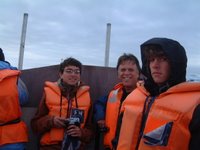
We arrive early and find the man in the yellow "lifewest." Thus begins an adventure with many firsts: our first trip on an amphibious vehicle, first trip on a glacial lagoon, first time to eat glacial ice (which happens to be 1,000-1,500 years old).
What we encounter is a nearly 700-foot-deep lagoon with icebergs floating in it. These icebergs are calved, or broken off of the many fingers of the large glacier which meets the lagoon waters. Only one tenth of the icebergs can be seen, while the bulk of them float below the water line. The colors are mystical and beautiful: crystal blues, shimmering whites, black patterns on the ice caused by lava sand. The deepest-blue 'bergs are ones that have turned over. Seven years from now
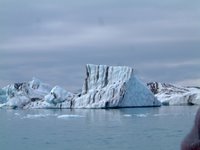 the largest of these icebergs will finally have melted.
the largest of these icebergs will finally have melted.A young man in an inflatable raft-boat with an outboard motor follows b
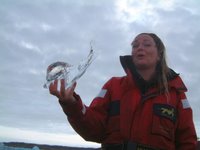 ehind us. His role may be to help our larger craft find the safest route through the icebergs, to pick up any tourists that fall overboard while leaning out to take photos, or to practice trick maneuvers...possibly all of the above. Our guide hands us a chunk of glacial ice which the raft guy has retrieved for her. We pass it around, examining it, and then she hammers it into pieces for us to breakfast upon. The ice is incredibly dense and clear, with no air bubbles in it...move over, Culligan! The photo opportunities are overwhelming, both from the boat as well as walking alongside the lagoon. We imagine that our friend Gunnella would need an entire day here with her camera.
ehind us. His role may be to help our larger craft find the safest route through the icebergs, to pick up any tourists that fall overboard while leaning out to take photos, or to practice trick maneuvers...possibly all of the above. Our guide hands us a chunk of glacial ice which the raft guy has retrieved for her. We pass it around, examining it, and then she hammers it into pieces for us to breakfast upon. The ice is incredibly dense and clear, with no air bubbles in it...move over, Culligan! The photo opportunities are overwhelming, both from the boat as well as walking alongside the lagoon. We imagine that our friend Gunnella would need an entire day here with her camera.If you want to see this ethereal sight for yourself, check out one of these James Bond films: A View to Kill, or Die Another Day.
Gabe is already out of film and wishing he had brought more with him. He purchases some at the gift shop, and after much picture-taking we continue counter-clockwise along the Ring Road. We arrive at the town of Hofn, situated on a large harbor with a fabulous view beyond of 4 or 5 glacial fingers reaching down from the massive Vatnasjokull glacier. We get gas and groceries, then reward ourselves with pastries and coffee--a developing ritual.
Now we head up into the East Fjords and, impossibly, the scenery becomes even more spectacular. Each fjord has its own unique characteristics, featuring towering, jagged peaks, sun-sparkled water, deep tunnels through mountains and road surfaces that change from paved to gravel and back. When we stop the car to get out and admire a view, it's a feast for all the senses: mountains and water as far as you can see, birds calling, warm sunshine, and a slight or strong breeze bringing a crisp, clean, fresh smell that you want to breathe in forever. It's sensory overload of a huge, peaceful kind; it's religion; it's Iceland!
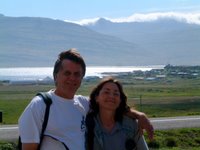 Lunch is an enjoyable interlude at Cafe Margret, a German restaurant/chalet/inn across from Breiddalsvik. The chalet is filled with paintings and drawings, antique furniture and china, and every surface, walls, ceiling, and floor, is smooth Finnish pine. Gabe and I share a dish of fresh cod with horseradish sauce, lime, potatoes and salad. It is very ample for the two of us, and is the best meal I've had in Iceland (so far). There are other discoveries here as well: a small inn upstairs, with cozy sitting rooms, overstuffed chairs, windows and skylights, balconies. A double room costs about $120. USD--I would love to return here and stay the night!
Lunch is an enjoyable interlude at Cafe Margret, a German restaurant/chalet/inn across from Breiddalsvik. The chalet is filled with paintings and drawings, antique furniture and china, and every surface, walls, ceiling, and floor, is smooth Finnish pine. Gabe and I share a dish of fresh cod with horseradish sauce, lime, potatoes and salad. It is very ample for the two of us, and is the best meal I've had in Iceland (so far). There are other discoveries here as well: a small inn upstairs, with cozy sitting rooms, overstuffed chairs, windows and skylights, balconies. A double room costs about $120. USD--I would love to return here and stay the night!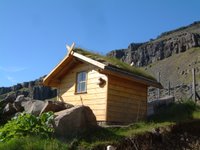 After lunch we investigate some of the outbuildings and discover the ultimate chicken house, complete with a boot functioning as a flower vase, a turf roof, and typical scandinavian wooden cross-bars (there must be a name for these) with chicken-head motifs. We take pictures so that Antonia can use the design as inspiration for her as-yet unbuilt chicken house.
After lunch we investigate some of the outbuildings and discover the ultimate chicken house, complete with a boot functioning as a flower vase, a turf roof, and typical scandinavian wooden cross-bars (there must be a name for these) with chicken-head motifs. We take pictures so that Antonia can use the design as inspiration for her as-yet unbuilt chicken house.Back in the car, many more fjords await us. We could eliminate a lot of snaking back and forth, and shorten the ride, but that would require traveling over large mountains with scary curves, no guardrails, and gravel surfaces. How can I enjoy th
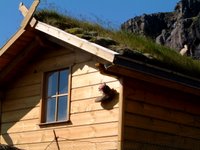 e view if I'm so terrified that my eyes are closed? The occupants of the car indulge Mom and we take the long way.
e view if I'm so terrified that my eyes are closed? The occupants of the car indulge Mom and we take the long way.The long way gives us the opportunity to see one very hot potato of a fjord, where divergent Icelandic political views focus on an Alcoa aluminum smelting plant. We can see the huge, sprawling plant across the fjord in the distance. What we can't see is what is being planned to power the plant: the damming of some of Iceland's wildest, largest, most pristine glacial rivers of the interior. This is a huge environmental controversy, and you can get a taste by looking at Saving Iceland.
Leaving the Alcoa site at Reydarfjördur we travel inland to Egilsstadir. We stop at a gas station adjacent to an outdoor soccer field that is ringed by rocks and...trees! We stop to enjoy an agressive game of soccer by two girls teams.
We continue our drive across the highlands, encountering lava deserts, sheep, fantastic rock formations, steep ravines and the unvaryingly spectacular scenery that you can't escape in Iceland. Our destination is Lake Myvatn, a favorite vacation spot.
Driving down to the lake we pass a plant where geothermal energy is harnessed to process diatomaceous earth that is dredged or excavated from the nearby lake. The word diatomite is familiar to us, but we are very surprised when we later look up the word and are reminded of its many uses! Check it out!
The diatomite plant is eerily beautiful at early dusk, with clouds of steam above aqua blue water ponds, in a s
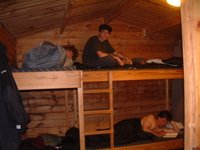 tark landscape. We read in our guidebook that there is a hot springs lagoon area, part of the plant, where the public can bathe. We can't wait to go...before bed, tonight!
tark landscape. We read in our guidebook that there is a hot springs lagoon area, part of the plant, where the public can bathe. We can't wait to go...before bed, tonight!Lodging is a tiny cabin in a campground. Really tiny...nothing but bunks, a little table, and a little porch. We share the bathrooms, showers and kitchen facilities with the tent campers. Our cabinette is on the shores of the lake, the shores themselves being immense, ridged lava fields. After unpacking and having a picnic ("snack") dinner, we jump in the car, excited (some of us, anyway) about our upcoming mineral bath.
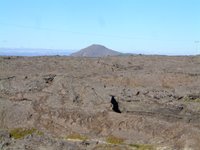
We don't know what to expect. The guidebook described how people used to bathe in geothermal ponds used by the diatomite plant, and how that was not necessarily very safe. Then the plant opened up an area specifically for the public to use. Would it be a pond in the middle of an empty lava field? Would other people be there? Would it be clothing optional? We figure that, worst case scenario, we could change into our swim suits in the car and wear our sandals to walk to the springs.
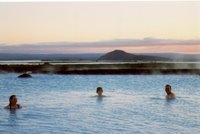
What we find is a small, not-very-commercial version of the Blue Lagoon. Although not nearly as large as its touristy cousin, this lagoon is still large, on a hill overlooking the lake. The bathing lagoon itself has the appearance of an "eternity pool" extending out to the skyline. There is an attractive, new building with a cafe, changing and shower facilities. It is a very chilly dash from the building to the lagoon, but the pool itself is hot enough to be nearly painful. Oh joy! From the surre
 al, steaming blue waters, perched on black lava rock seats we watch the sun dip past the lagoon, the lake, and the horizon as it approaches midnight. Sulphuric smells arise with the steam, and the water has an extremely soft, silky, alkaline feel to it--it is supposed to be very good for skin conditions. Gabriel is frustrated to be without his camera. He is willing to dash inside through the cold to retrieve it, and to risk ruining his 35mm antique (my Minolta from 1969) by taking it into the lagoon to document this event. Thank you, Gabe!
al, steaming blue waters, perched on black lava rock seats we watch the sun dip past the lagoon, the lake, and the horizon as it approaches midnight. Sulphuric smells arise with the steam, and the water has an extremely soft, silky, alkaline feel to it--it is supposed to be very good for skin conditions. Gabriel is frustrated to be without his camera. He is willing to dash inside through the cold to retrieve it, and to risk ruining his 35mm antique (my Minolta from 1969) by taking it into the lagoon to document this event. Thank you, Gabe!We sleep well in our mini-cabin, totally relaxed.
High 60° Low 46°
7 comments:
Quick question, if you can recall: How much for a single bunk cabin? Or, for what you had in the picture?
Cheers!
Joel,
To give you an idea, the cost for a cabin (with bath) near Vík was USD $65 for four, while the cabin in the campground at Lake Myvatn was $110 without bath. We paid $250/night in Reyjavik (for a room with a kitchen), and everywhere else we paid between $65.-140., for four.
Definitely bring a sleeping bag, because that cuts the costs at almost any cabin/inn/guesthouse since you won't require sheets. To save money, either camp, or stay at places where you can prepare some of your meals. We never ate out more than one meal a day; we always packed a lunch and ate breakfast in. Then we could slurge on a good dinner and enjoy the local cuisine!
Where do you live--what type of weather are you used to? Tent camping is certainly the most economical, but the weather is so changeable that you have to be willing to put up with cool weather, rain, wind, possible lava sand storms. No bugs, though! This trip journal probably won't give you an accurate idea of typical weather, as it was unusually nice for our entire trip--or, I should say, the bad weather happened to be where we weren't :-)
The cabin at Vík was the really cute one, one of our favorites of the trip:
http://photos1.blogger.com/blogger/4714/1636/1600/cabin.jpg
Joel,
To give you an idea, the cost for a cabin (with bath) near Vík was USD $65 for four, while the cabin in the campground at Lake Myvatn was $110 without bath. We paid $250/night in Reyjavik (for a room with a kitchen), and everywhere else we paid between $65.-140., for four.
Definitely bring a sleeping bag, because that cuts the costs at almost any cabin/inn/guesthouse since you won't require sheets. To save money, either camp, or stay at places where you can prepare some of your meals. We never ate out more than one meal a day; we always packed a lunch and ate breakfast in. Then we could slurge on a good dinner and enjoy the local cuisine!
Where do you live--what type of weather are you used to? Tent camping is certainly the most economical, but the weather is so changeable that you have to be willing to put up with cool weather, rain, wind, possible lava sand storms. No bugs, though! This trip journal probably won't give you an accurate idea of typical weather, as it was unusually nice for our entire trip--or, I should say, the bad weather happened to be where we weren't :-)
I am currently living in Victoria, British Columbia. From Vancouver as well. Grew up in the Rockies in Tete Jaune Cache, BC. Moved to Kamloops, a semi-desert and hot like India in the summers, and cold in the winters. Now in Victoria, it is quite mild in the summer and winter. Not as mild as Iceland I think. But I went to college in Saskatchewan, just finished, and there the winters and summers can be extreme. Huge wind chil factor. The cold being a dry cold though, whereas in Victoria it is damp and seeps into your bones (like Seattle). The non-existence of bugs sounds very nice!
Well, there's more here than what you asked for. Note to self, check the weather before I decide to tent it. I am hoping that places will be cheaper since I only want a crawl space or a single bed to curl up into.
Thanks Rose.
And those lava sand storms do sound interesting.
Joel,
With the variety of climates you've lived in, you'll be fine! We lived in Iowa 5 years, and those cold, arctic winds-wow!
My daughter went to BC in May, and my Dad and his wife just a few weeks ago. That's a lovely part of the world I would like to visit as well. There is nothing as big as the Rockies, or the Sierras, here on the east coast.
That’s great! I am glad they get the chance to come out here. And, as for your bit of shire, I wouldn't write the east coast off too quickly. I may dream of Virginia as often as Iceland. Thanks to Annie Dillard and others the area is a draw for me - Appalachians and all. One day.
Again fantastic pictures and travel narrative in the mix!
Post a Comment